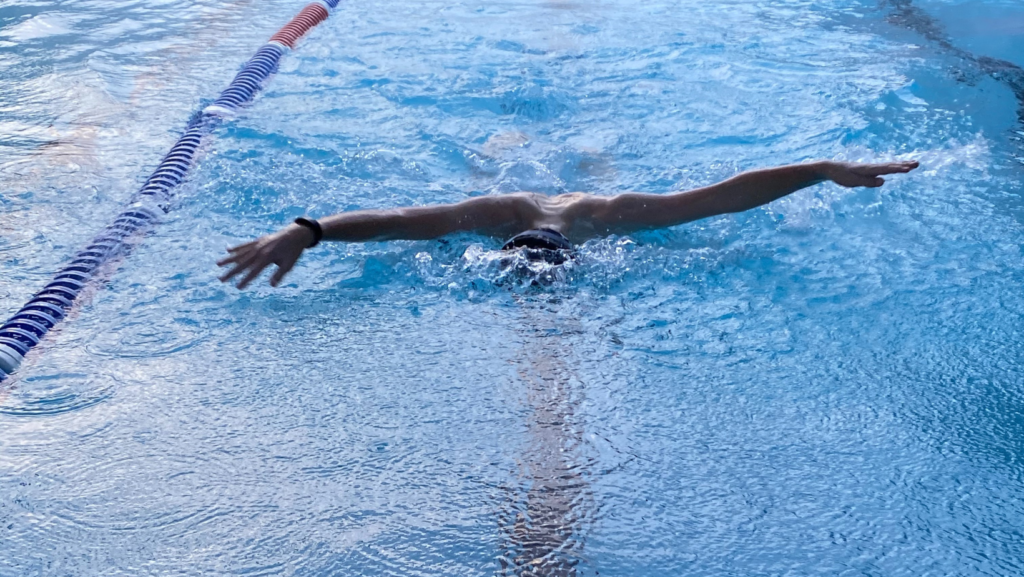How to swim Butterfly
Butterfly is arguably swimming’s most challenging stroke. If you’re like 95% of swimmers, then you’ve probably had trouble mastering the ins and outs the butterfly.
 However, when it’s done properly, butterfly can rev up your metabolism, build impressive muscular strength and give you one hell of a workout.
However, when it’s done properly, butterfly can rev up your metabolism, build impressive muscular strength and give you one hell of a workout.
It requires strength in all parts of your body, endurance, technique, and a lot of practice! And that’s what we will do next week. There are so many ways to practice your Butterfly skills.
We’ll walk through 10 great ‘drills’ that will make you FLY HIGH.
- Practice outside of the water – Lay on your stomach by the side of the pool and visualise the mechanics of the butterfly stroke. Bend your knees slightly to mimic the leg kick as your hands come forward and enter the imaginary water in front of you. Perform another kick when your arms reach your sides. This drill helps you to get a feeling for the timing of the stroke before you enter the water.
- Practice with short fins – Swim fins make a great tool to practice your butterfly. Swim the butterfly with short swim fins, taking one arm stroke for every 3-4 leg kicks. Focus on the form of your leg kick during this drill. The added resistance provided by the fins will allow more sensory response to the movement of your legs through the stroke.
- Butterfly with a board – This is where the kickboard comes in. Keep a firm grip on the kickboard and practice your butterfly kicking technique. If you can, allow the kickboard to dive under the water in front of you and then come back to the surface as you complete your kicking cycle. This will help you to master the undulating motion involved in the stroke.
- Dive like a dolphin – To understand that your hips help to drive a stronger and better dolphin kick, imagine how a dolphin jumps out of the water before diving back in. In the same vein, it’s similar to how when we dive down for a handstand, we bend from our hips and dip our head towards the bottom of the pool. When we add our dolphin dive after we recover our arms to our head, we achieve a better undulating motion as well as a stronger kick.
- Use a pull buoy – Place a pull buoy between your legs and swim butterfly using only your arms. This drill will improve your arm strength and help you focus on proper upper-body mechanics and why our head position helps us through the water. Try to pull equally with both your right arm and left arm during each stroke you take.
- Practice with one arm – Swim the butterfly using just one arm without moving the other. Keep the arm that is not in use extended out in front of you or along your side. It is extremely important to breathe forward and not laterally when performing this drill.
- Go for a flutter kick – Swim the butterfly using a freestyle leg kick. Try to keep your shoulders above the water when performing this drill. Focus on your arm mechanics. Practice a powerful pull-through and efficient recovery phase.
- Follow this entry cycle – As you swim, your first stroke should have a wide hand entry. In your second stroke, your hand should enter the water at half the width of your previous stroke. For your third stroke, your hands should enter the water next to one another in front of your head. Your fourth stroke will return to the original wide entry. Repeat this different entries cycle throughout the drill.
- Recover underwater – Swim the butterfly without the recovery part of the arm stroke. Make sure your arms are below your chest and try to go as deep as possible with your shoulders by thrusting your back powerfully downward.
- Clench those fists – Swim the butterfly with clenched fists to keep your arms and legs as coordinated as possible, feeling the water push against your arms.
While you’re mastering this stroke, it is a great idea to start timing yourself. Swimming 50 metres,100 meters, and 200 meters. Keeping a log of your times throughout practicing your butterfly will show how much you are improving.
